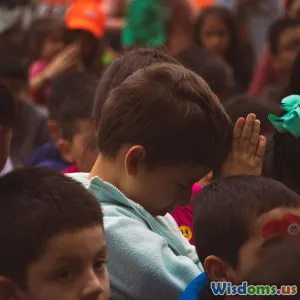
Unlocking the Power of Prayer A Christian Clergys Daily Rituals Revealed
9 min read Explore the transformative daily prayer rituals of Christian clergy and how they unlock spiritual power and deep connection with faith. (0 Reviews)
Unlocking the Power of Prayer: A Christian Clergy's Daily Rituals Revealed
Prayer transcends spoken words, becoming a potent spiritual force that shapes the lives of many, particularly Christian clergy whose days revolve around this sacred discipline. But what makes prayer so transformative? How do clergy members translate routine acts of prayer into a daily ritual that empowers their faith, sustains their energy, and anchors their ministry?
This article reveals the deeply personal yet universally instructive rituals of prayer embraced by Christian clergy around the world. Through their examples, supported by theological insights and real-world applications, we open a window into the power of prayer as a life-shaping tool.
The Spiritual Foundation of Clergy Prayer
Christian clergy approach prayer not merely as rote repetition but as a dynamic conversation with God. This relationship is grounded in biblical precedent, personal devotion, and communal responsibility.
Biblical Models Inform Daily Practice
Clergy rituals often reflect biblical exemplars of prayer—from Jesus retreating to solitary mountains (Luke 5:16) to the Apostle Paul's prayers for the churches (Ephesians 1:16-17). These stories inspire clergy to balance meditative silence with intercessory zeal.
For instance, ministers will invoke the Psalms to shape prayers of lament, praise, or thanksgiving, as King David teaches. This scriptural guidance ensures prayers remain rooted in tradition and rich theological meaning.
Personal Devotion and Clergy Well-being
Clergy testimony often highlights prayer as central to their mental and emotional well-being. The responsibilities of pastoral care—comforting the sick, guiding the disillusioned, and preaching hope—can induce spiritual fatigue.
Daily prayer rituals serve as a restorative refuge. As Rev. Joanne Hayes, a pastor in Chicago, shares: "Prayer in the morning refocuses me, a spiritual reset that keeps me grounded throughout the day's demands."
Components of Clergy Daily Prayer Rituals
While styles vary among denominations and individuals, several core components are common.
1. Morning Devotion and Meditation
Most clergy commence the day with prayer, often accompanied by scripture reading and meditation. This quiet time is essential for setting a tone of peace and spiritual alertness.
A common practice is the "Lectio Divina," an ancient method involving slow, reflective reading of scripture, followed by meditation, prayer, and contemplation. This encourages an intimate encounter with God’s Word, providing fresh insights tailored to the day's challenges.
2. Intercessory Prayer
Clergy regularly intercede for their congregation, community, and even global issues during scheduled prayer times. For example, the Church of England encourages daily intercession cycles where specific regions or concerns are prayed for systematically.
Such intentional, community-focused prayer underscores the interconnectedness of ministry and the collective nature of Christian faith.
3. Prayer Journaling
Many clergy keep prayer journals to record petitions, reflections, and perceived answers. This practice fosters mindfulness and an ongoing dialogue with God.
According to a survey by the National Clergy Resilience Resource, 68% of clergy who use prayer journals report greater spiritual clarity and emotional resilience over time.
4. Evening Reflection and Gratitude
Ending the day with prayer fosters gratitude and self-examination. Clergy often review daily events, seeking where they discerned God’s presence or missed opportunities for grace.
This habit supports humility, accountability, and a peaceful closure to the day, vital in maintaining long-term spiritual health.
Integrating Prayer into Ministry and Leadership
Beyond private devotion, prayer deeply influences clergy leadership.
Decision-Making Rooted in Prayer
When faced with difficult pastoral decisions—like counseling sensitive family issues or community disputes—prayer becomes a decision-making compass.
Dr. Samuel Thompson, a seminary professor, notes: "Praying before decisions invites divine wisdom often lacking in secular leadership. Clergy who consistently seek God in prayer tend to lead with greater compassion and insight."
Prayer as a Model for Congregations
Clergy also serve as spiritual role models by sharing their prayer practices during worship, study groups, and one-on-one mentoring.
For example, Rev. Maria Sanchez incorporates prayer teaching into weekly sermons, demystifying different prayer forms and inviting congregants into deeper engagement.
This practice cultivates a community atmosphere where prayer is both personal and corporate.
Use of Prayer in Rituals and Ceremonies
Daily prayer rituals extend into liturgies such as the Liturgy of the Hours, where clergy recite fixed psalms and prayers at set times throughout the day.
This rhythm connects clergy globally through shared prayer cycles, emphasizing continuity, unity, and the sanctification of daily life.
Real-World Impact: Stories of Transformation
Healing Through Persistent Prayer
A notable example comes from Pastor David Miller, who attributes his congregation's spiritual renewal amidst a community crisis to persistent prayer focuses, including healing intercession and peace petitions.
His story echoes widespread reports that prayer deployed with faith can catalyze emotional healing and communal revival.
Strengthening Mental Health in Clergy
Data published in the Journal of Religion and Health highlights that clergy who engage in structured daily prayer report significantly reduced burnout rates and higher life satisfaction compared to non-praying counterparts.
This emphasizes prayer’s practical role in protecting those who serve under intense pressures.
Practical Tips to Adopt Clergy Prayer Rituals
For readers inspired to enrich their own spiritual practice, here are actionable steps:
- Begin with intentional, daily morning prayer and scripture meditation. Even 10-15 minutes can re-orient your mindset.
- Establish intercessory prayer habits by praying specifically for people or issues. Use prayer lists or apps to stay organized.
- Record your prayers and reflections. Journaling promotes spiritual growth and maintains awareness of God's responses.
- Create evening gratitude and self-reflection routines. End your day focused and peaceful.
- Explore communal prayer opportunities. Join prayer groups or services that foster collective spiritual support.
Conclusion: Unlocking Spiritual Power in Daily Prayer
The daily rituals of Christian clergy reveal prayer as much more than a religious obligation—it is a transformative force that nurtures faith, inspires compassionate leadership, and sustains spiritual vitality. Through structured practices like morning devotion, intercession, journaling, and reflection, clergy cultivate a deep, powerfully connected relationship with God that not only enriches their own lives but also empowers and heals their communities.
By embracing these prayer rituals, believers can also unlock the profound power of prayer, experiencing its life-changing potential beyond the clergy and into their own personal journeys of faith.
Reflect on your own routines: How might incorporating these time-honored prayer practices reshape your spiritual life and leadership? The path is open, illuminated by the steady glow of disciplined prayer.
Rate the Post
User Reviews
Popular Posts




















